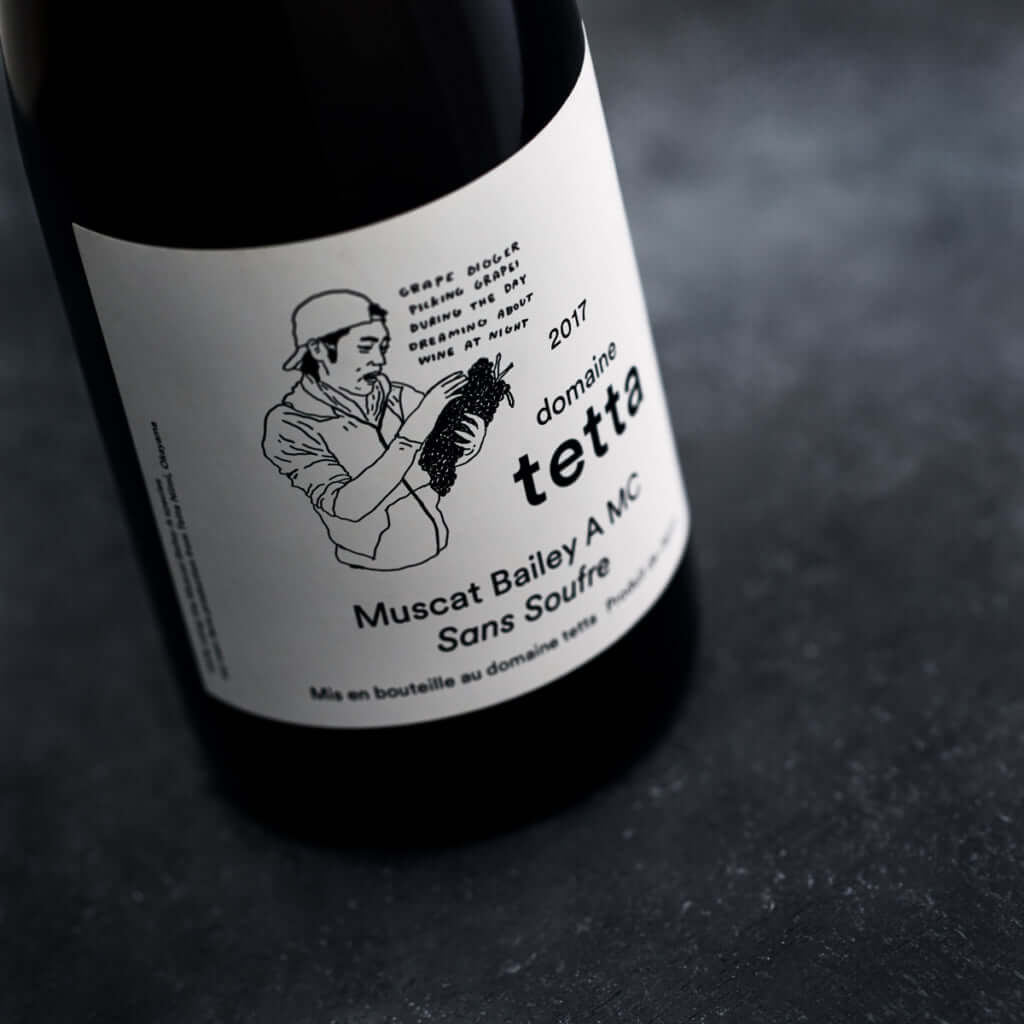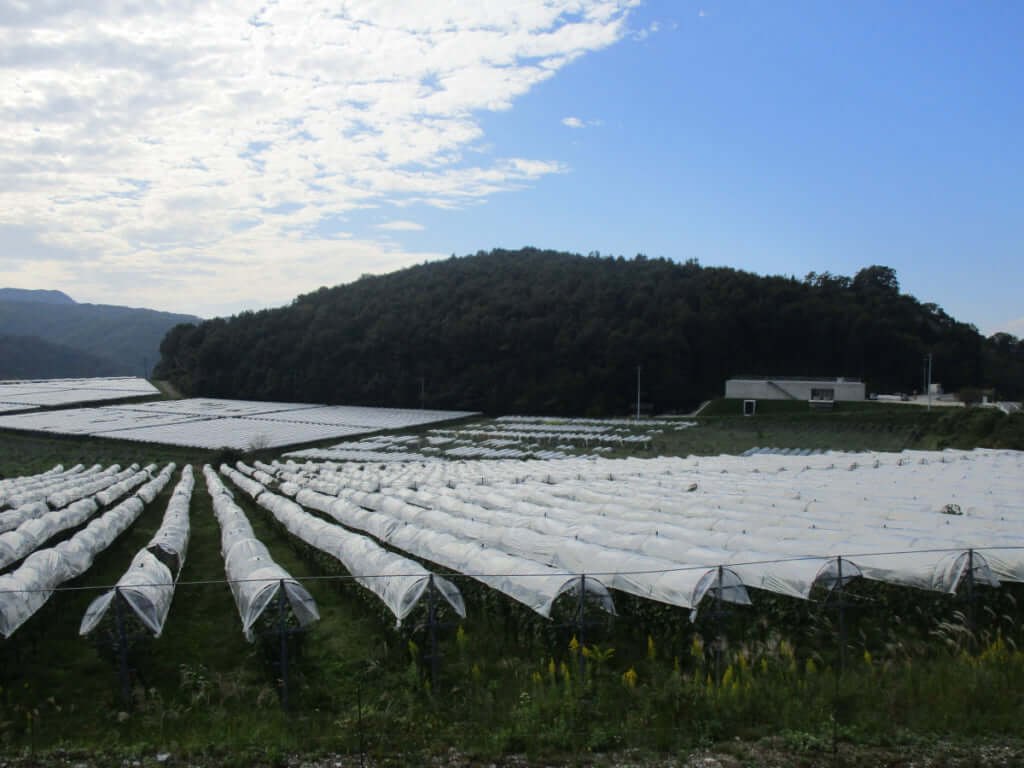Slides so Smoothly Down the Throat, this Red Wine is Gone Before You Know It
Domaine Tetta, 2017 Muscat Bailey A MC Sans Soufre

In 2016, a new winery came into being in Niimi City, Okayama Prefecture, named ‘Domaine Tetta’. Organized as an agricultural production corporation to produce wine, all wine made here is grown and produced in-house, as the use of the word ‘Domaine’* indicates. The entire wine-making process, from viniculture to vinification, is in the hands of Hiroaki Katayose. Trusting in the natural power of grapes, he waits for the freshly-pressed grape juice, free of added sugar or acids, to start fermenting spontaneously. Katayose explains why as follows.
‘It doesn’t make any sense to diligently cultivate a terroir, and then use yeast brought from overseas to make the wine. My idea is to let the wild yeast ferment the grapes, and to limit the amount of sulfites and other additives, because I want a beverage that is close to 100% grapes, pure and unadorned—the way wine should be. Wouldn’t that be the sensible way, to make wine that reflects the terroir?’
Furthermore, Katayose himself tends to be allergic to sulfites, and if a certain level of sulfites is exceeded, he gets headaches and may even become asthmatic. However, if he drinks what is considered to be natural wine, these symptoms are either completely absent, or very mild. The desire to produce wine that is gentle on the human body lies at the deepest levels of his thinking. The 2017 Muscat Bailey A MC Sans Soufre is completely free of sulfites (‘sans soufre’ means ‘without sulfur’ in French). After the tanks are packed with grape clusters and filled with carbon dioxide gas, about three weeks of patience (!). Then, the juice is squeezed out and allowed to ferment leisurely for about 4 months, then bottled immediately before fermentation has completely finished. No extractive operations, such as punching down the mash or centrifuging the juice in order to draw components from the grape skins, are carried out. To Katayose, this is what ‘wine made by the natural power of grapes’ means. Consistent with this approach, the amount of chemical fertilizer is kept to a minimum, and completely removing unhealthy grapes from the vines is an on-going effort.
When I first met Katayose two years ago, he had just started making wine on land that had never before been used for wine production. At that time, he told me that ‘Although not all the conditions were right, I believe in the potential of this land and I accept the challenge. Probably only a handful of people can make wine so good that it lingers in a person’s mind, but that’s exactly where I want to go: off on a marvelously unlimited adventure’.
The 2017 Sans Soufre wine—as it gently effervesces in your mouth, aromas of strawberry, raspberry, plum, cinnamon, anise, and orange course along, one after another. Like freshly squeezed fruit juice that slides smoothly down the throat, it elicits a spontaneous ‘Yum!’ Before you know it, you’ve drunk the glass dry. What a cute little wine!
※In France, the term ‘domaine’ is restricted to wineries in which the cultivation is 100% owned by the winery, and the wine is produced only from grapes entirely under the management of the winery.


Domaine Tetta
Area under direct cultivation: 8 ha (of which 4 ha are devoted to wine, and 3 ha can be harvested)
Name of fermenter: Hiroaki Katayose
Variety and origin: 1. Chardonnay, 2. Muscat Bailey A, 3. Merlot, 4. Cabernet Franc, 5. Pinot Noir, 6. Sauvignon Blanc, 7. Chenin Blanc, 8. Pinotage, 9. Petit Manseng, 10. Nebbiolo, 11. Pinot Gris, 12. Albariño [Alvarinho], 13. Tannat, 14. Sangiovese, 15. Steuben, 16. Viognier, 17. Koshu, 18. Riesling, 19. Kerner, and 20. Pinot Blanc. Because at least 50 vines each of the above varieties are in cultivation, varietals can be produced without any blending. There are 10 more varieties in the vineyard (the above relates to Tetta-cho, Niimi City, Okayama Prefecture).
Volume: 750 ml
Price: ¥2,808 (including tax)
Vinification: Grapes remain in the clusters for 3 weeks, then juice is taken and fermented for about 4 months with wild yeast. No sulfites or enzymes are added. No sugar or acid is added. No herbicides or synthetic fertilizers are spread during cultivation. Pesticide spraying has been reduced from 12 times annually to 8 times, and in some areas, to just 6 times. Insecticide use is transitioning from 4 times to about 1 time. Application of Bordeaux mixture has been reduced from 5 times to 3. Usage of other fungicides is being cut back, or restricted to a less concentrated form.
Telephone: 0867-96-3658
tetta.jpNOTE: The 'Natural Wines' series introduces naturalist wines and natural wines produced as naturally as possible over all stages from grape cultivation to fermentation. What exactly does 'as naturally as possible' mean? In this series, it means 'minimal human intervention' during the secondary fermentation process. It also means 'no addition of sulfites during primary fermentation and bottling', or perhaps 'sulfites limited to an absolute minimum amount', and 'depending on natural yeast, without using cultured yeast, without additives'. Other expectations include 'No sugars are added, no adjustment with acids, no finishing agents, and generally no filtration'. In terms of grape cultivation, the basic premise is to avoid using synthetic agricultural chemicals, but growing wine varietals in the Japanese climate by organic methods is extremely problematic at present, so keeping the use of agricultural chemicals to a bare minimum is a reasonable expectation. As a general rule, herbicides and chemical fertilizers should be completely avoided. To successfully make wine in this way, grapes must be kept robust, and conscientious oversight of the fermentation process is indispensable. The vintners who succeed in raising grapes as naturally as possible in respect of the terroir, and the wines that they produce, are the deserving subjects of this series.
TRENDING
-
A House from the Taisho Era Reveals Its Secrets
While visiting an abandoned building, Hamish Campbell discovered photographs the owner had taken of the place in the 1920s.

-
The Taboo-Breaking Erotica of Toshio Saeki
The master of the 1970s Japanese avant-garde reimagined his most iconic artworks for a limited box set with silkscreen artist Fumie Taniyama.

-
With Meisa Fujishiro, Tokyo's Nudes Stand Tall
In the series 'Sketches of Tokyo', the photographer revisits the genre by bringing it face to face with the capital's architecture.

-
Masahisa Fukase's Family Portraits
In his series ‘Family’, the photographer compiles surprising photos in which he questions death, the inescapable.

-
Hajime Sorayama's Futuristic Eroticism
The illustrator is the pioneer for a form of hyperrealism that combines sensuality and technology and depicts sexualised robots.





